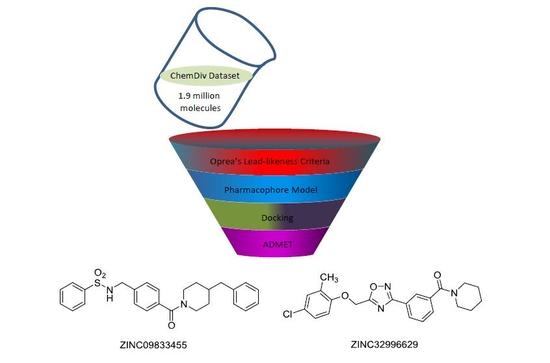Virtual Screening of Small Molecular Inhibitors against DprE1
Abstract
:1. Introduction
2. Results and Discussion
3. Materials and Methods
3.1. Preparation for Virtual Screening
3.2. First Round of Screening Based on Oprea’s Lead-Likeness Criteria
3.3. Second Round of Screening Based on Pharmacophore Models
3.4. Third Round of Screening Based on Docking
3.5. ADMET Prediction
4. Conclusions
Supplementary Materials
Acknowledgments
Author Contributions
Conflicts of Interest
References
- Global Tuberculosis Report 2016, 21st ed.; WHO: Geneva, Switzerland, 2016.
- Velayati, A.A.; Masjedi, M.R.; Farnia, P.; Tabarsi, P.; Ghanavi, J.; ZiaZarifi, A.H.; Hoffner, S.E. Emergence of new forms of totally drug-resistant tuberculosis bacilli. Chest 2009, 136, 420–425. [Google Scholar] [CrossRef] [PubMed]
- Wolucka, B.A. Biosynthesis of d-Arabinose in mycobacteria—A novel bacterial pathway with implications for antimycobacterial therapy. FEBS J. 2008, 275, 2691–2711. [Google Scholar] [CrossRef] [PubMed]
- Mikusova, K.; Huang, H.; Yagi, T.; Holsters, M.; Vereecke, D.; D’Haeze, W.; Scherman, M.S.; Brennan, P.J.; McNeil, M.R.; Crick, D.C. Decaprenylphosphoryl arabinofuranose, the donor of the d-arabinofuranosyl residues of mycobacterial arabinan, is formed via a two-step epimerization of decaprenylphosphoryl ribose. J. Bacteriol. 2005, 187, 8020–8025. [Google Scholar] [CrossRef] [PubMed]
- Makarov, V.; Manina, G.; Mikusova, K.; Möllmann, U.; Ryabova, O.; Saint-Joanis, B.; Dhar, N.; Pasca, M.R.; Buroni, S.; Lucarelli, A.P.; et al. Benzothiazinones kill Mycobacterium tuberculosis by blocking arabinan synthesis. Science 2009, 324, 801–804. [Google Scholar] [CrossRef] [PubMed]
- Makarov, V.; Lechartier, B.; Zhang, M.; Neres, J.; van der Sar, A.M.A.M.; Raadsen, S.A.S.A.; Hartkoorn, R.C.R.C.; Ryabova, O.B.O.B.; Vocat, A.; Decosterd, L.A.L.A.; et al. Towards a new combination therapy for tuberculosis with next generation benzothiazinones. EMBO Mol. Med. 2014, 6, 372–383. [Google Scholar] [CrossRef] [PubMed]
- Trefzer, C.; Rengifo-Gonzalez, M.; Hinner, M.J.; Schneider, P.; Makarov, V.; Cole, S.T.; Johnsson, K. Benzothiazinones: Prodrugs that covalently modify the decaprenylphosphoryl-β-d-ribose 2′-epimerase DprE1 of mycobacterium tuberculosis. J. Am. Chem. Soc. 2010, 132, 13663–13665. [Google Scholar] [CrossRef] [PubMed]
- Magnet, S.; Hartkoorn, R.C.; Székely, R.; Pató, J.; Triccas, J.A.; Schneider, P.; Szántai-Kis, C.; Őrfi, L.; Chambon, M.; Banfi, D.; et al. Leads for antitubercular compounds from kinase inhibitor library screens. Tuberculosis 2010, 90, 354–360. [Google Scholar] [CrossRef] [PubMed]
- Stanley, S.A.; Grant, S.S.; Kawate, T.; Iwase, N.; Shimizu, M.; Wivagg, C.; Silvis, M.; Kazyanskaya, E.; Aquadro, J.; Golas, A.; et al. Identification of novel inhibitors of m. tuberculosis growth using whole cell based high-throughput screening. ACS Chem. Biol. 2012, 7, 1377–1384. [Google Scholar] [CrossRef] [PubMed]
- Neres, J.; Hartkoorn, R.C.; Chiarelli, L.R.; Gadupudi, R.; Pasca, M.R.; Mori, G.; Venturelli, A.; Sacina, S.; Makarov, V.; Kolly, G.S.; et al. 2-Carboxyquinoxalines kill Mycobacterium tuberculosis through noncovalent inhibition of DprE1. ACS Chem. Biol. 2015, 10, 705–714. [Google Scholar] [CrossRef] [PubMed]
- ChemDiv Dataset ZINC Database. Available online: http//zinc.docking.org/catalogs/cdiv (accessed 10 June 2016).
- Oprea, T.I.; Davis, A.M.; Teague, S.J.; Leeson, P.D. Is there a difference between leads and drugs? A historical perspective. J. Chem. Inf. Comput. Sci. 2001, 41, 1308–1315. [Google Scholar] [CrossRef] [PubMed]
- Palm, K.; Stenberg, P.; Luthman, K.; Artursson, P. Polar molecular surface properties predict the intestinal absorption of drugs in humans. Pharm. Res. 1997, 14, 568–571. [Google Scholar] [CrossRef] [PubMed]
- Leo, A.; Hansch, C.; Elkins, D. Partition coefficients and their uses. Chem. Rev. 1971, 71, 525–616. [Google Scholar] [CrossRef]
- Egan, W.J.; Merz, K.M.; Baldwin, J.J. Prediction of drug absorption using multivariate statistics. J. Med. Chem. 2000, 43, 3867–3877. [Google Scholar] [CrossRef] [PubMed]
- Chemistry Collection: Basic Chemistry User Guide, Pipeline Pilot; Accelrys Software Inc.: San Diego, CA, USA, 2011.
- Wang, B.; Yang, L.-P.; Zhang, X.-Z.; Huang, S.-Q.; Bartlam, M.; Zhou, S.-F. New insights into the structural characteristics and functional relevance of the human cytochrome P450 2D6 enzyme. Drug Metab. Rev. 2009, 41, 573–643. [Google Scholar] [CrossRef] [PubMed]
- Pirmohamed, M.; Breckenridge, A.M.; Kitteringham, N.R.; Park, B.K. Fortnightly review: Adverse drug reactions. BMJ Br. Med. J. 1998, 316, 1295–1298. [Google Scholar] [CrossRef]
- Moroy, G.; Martiny, V.Y.; Vayer, P.; Villoutreix, B.O.; Miteva, M.A. Toward in silico structure-based ADMET prediction in drug discovery. Drug Discov. Today 2012, 17, 44–55. [Google Scholar] [CrossRef] [PubMed]
- Trott, O.; Olson, A.J. AutoDock Vina: Improving the speed and accuracy of docking with a new scoring function, efficient optimization, and multithreading. J. Comput. Chem. 2010, 31, 455–461. [Google Scholar] [CrossRef] [PubMed]
- O’Boyle, N.M.; Banck, M.; James, C.A.; Morley, C.; Vandermeersch, T.; Hutchison, G.R. Open Babel: An open chemical toolbox. J. Cheminform. 2011, 3, 33. [Google Scholar] [CrossRef] [PubMed]
- Autogrid. Available online: http://autodock.scripps.edu/wiki/AutoGrid (accessed on 26 February 2018).
- Lagorce, D.; Reynes, C.; Camproux, A.-C.; Miteva, M.A.; Sperandio, O.; Villoutreix, B.O. In silico adme/tox Predictions. In ADMET for Medicinal Chemists; John Wiley & Sons, Inc.: Hoboken, NJ, USA, 2010; pp. 29–124. [Google Scholar]
Sample Availability: Samples of the compounds are not available from the authors. |
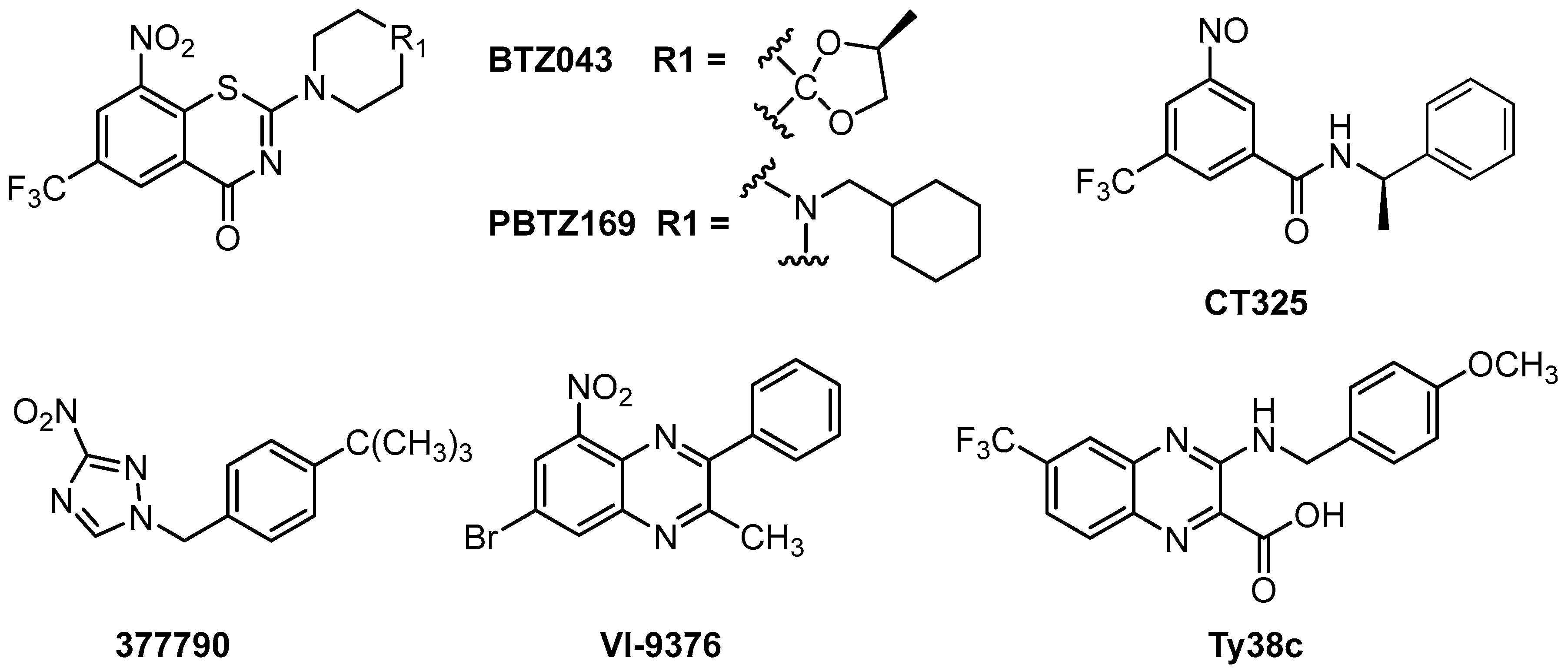
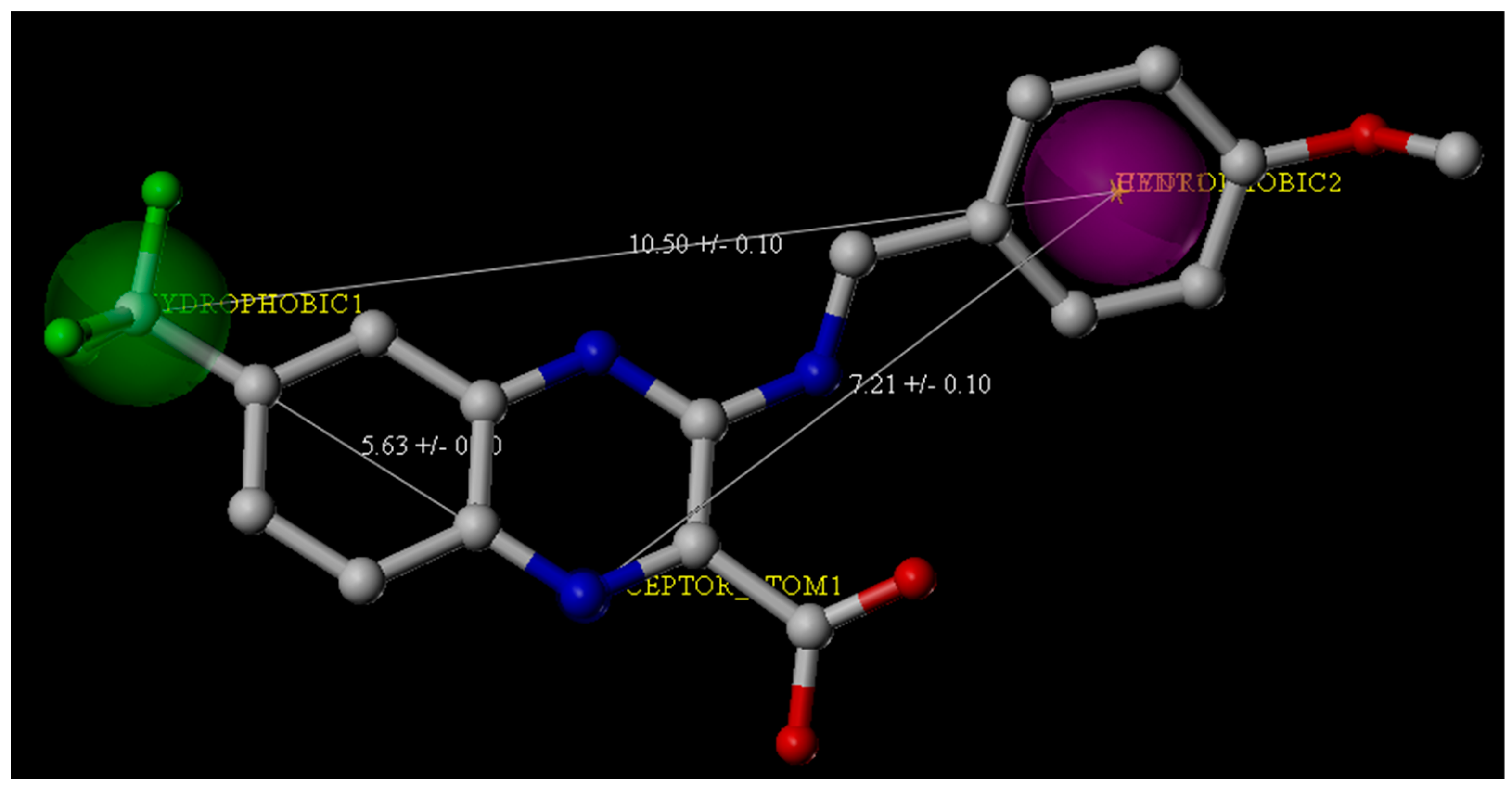
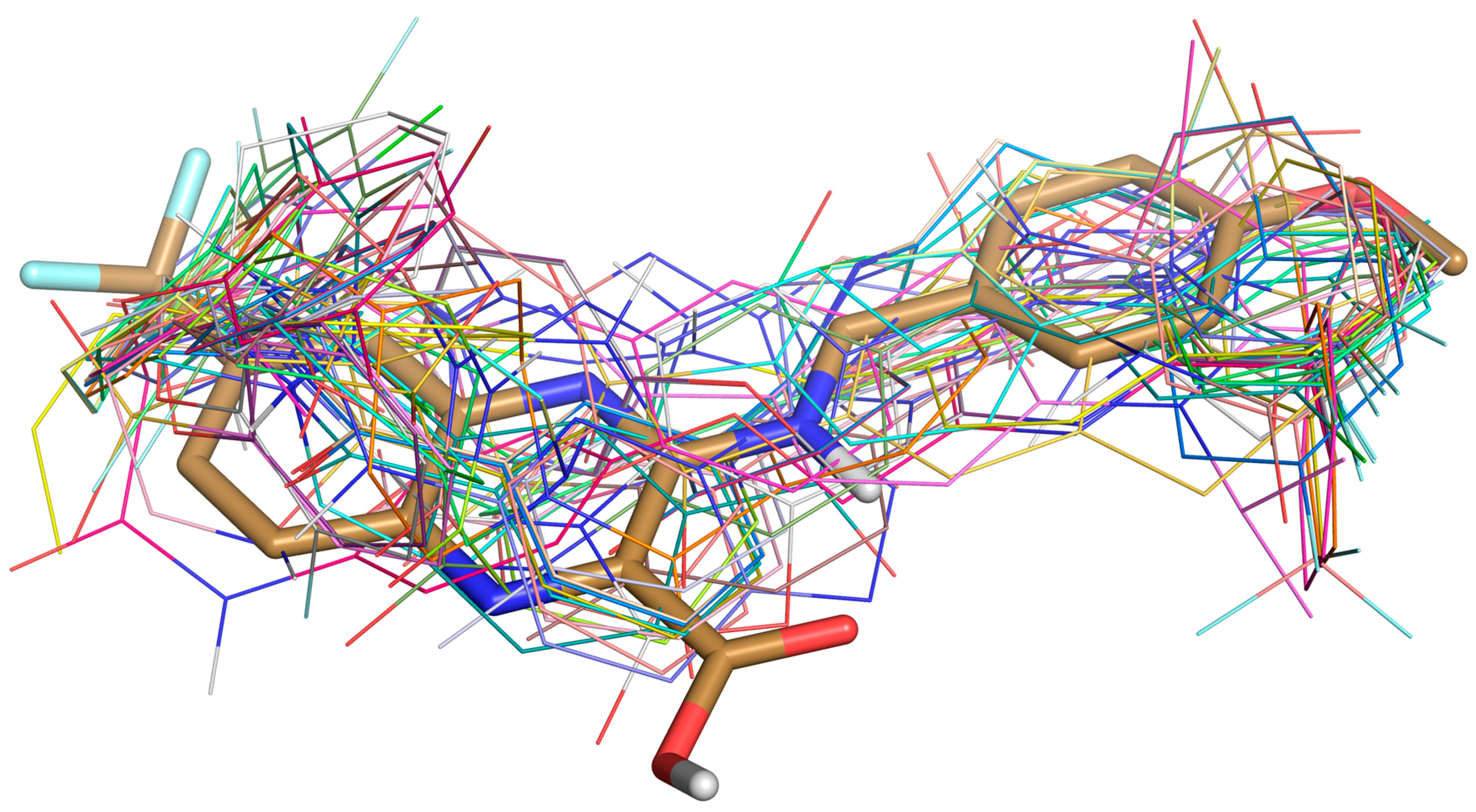
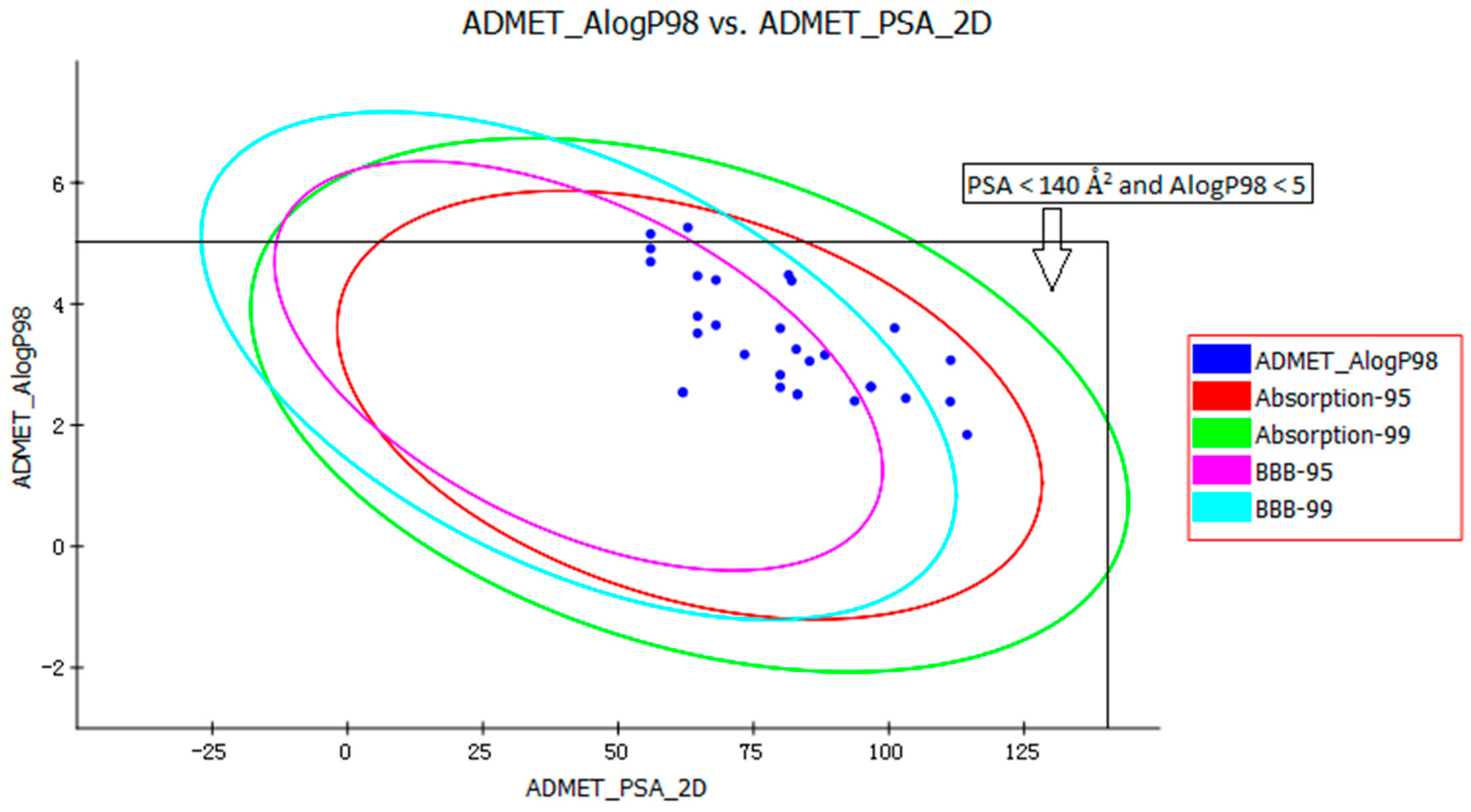

| Compounds | BBB Level a | Absorption Level b | Solubility Level c | Hepatotoxicity d | CYP2D6 e | PPB Level f | AlogP98 | PSA 2D |
|---|---|---|---|---|---|---|---|---|
| ZINC04497363 | 3 | 0 | 2 | 0 | 0 | 2 | 2.506 | 83.12 |
| ZINC04497364 | 3 | 0 | 2 | 0 | 0 | 2 | 2.506 | 83.12 |
| ZINC04724734 | 2 | 0 | 2 | 1 | 1 | 1 | 4.478 | 81.485 |
| ZINC05196271 | 2 | 0 | 2 | 1 | 0 | 2 | 3.253 | 82.903 |
| ZINC08614786 | 2 | 0 | 2 | 1 | 0 | 2 | 3.167 | 73.348 |
| ZINC09502318 | 3 | 0 | 2 | 0 | 0 | 2 | 3.16 | 88.19 |
| ZINC09743860 | 2 | 0 | 2 | 1 | 0 | 1 | 4.382 | 82.052 |
| ZINC09833455 | 1 | 0 | 2 | 0 | 0 | 2 | 4.395 | 68.065 |
| ZINC12249931 | 4 | 0 | 2 | 1 | 0 | 0 | 3.602 | 101.082 |
| ZINC15858572 | 3 | 0 | 2 | 1 | 0 | 0 | 3.056 | 85.365 |
| ZINC15865571 | 2 | 0 | 2 | 1 | 0 | 2 | 3.597 | 79.947 |
| ZINC17149731 | 2 | 0 | 2 | 0 | 0 | 1 | 3.65 | 68.065 |
| ZINC21100102 | 3 | 0 | 3 | 1 | 0 | 2 | 2.624 | 79.947 |
| ZINC21100117 | 3 | 0 | 3 | 1 | 0 | 2 | 2.83 | 79.947 |
| ZINC21884825 | 3 | 0 | 3 | 0 | 0 | 2 | 2.444 | 103.141 |
| ZINC21884833 | 2 | 0 | 2 | 0 | 0 | 2 | 3.797 | 64.659 |
| ZINC23333900 | 1 | 0 | 1 | 1 | 0 | 2 | 5.261 | 62.856 |
| ZINC32996629 | 1 | 0 | 2 | 0 | 0 | 2 | 4.462 | 64.659 |
| ZINC33123019 | 4 | 0 | 2 | 0 | 0 | 0 | 3.071 | 111.432 |
| ZINC33257862 | 2 | 0 | 2 | 0 | 0 | 2 | 3.517 | 64.659 |
| ZINC35480955 | 1 | 0 | 2 | 0 | 0 | 1 | 4.912 | 55.985 |
| ZINC35511826 | 1 | 0 | 2 | 0 | 0 | 1 | 4.696 | 55.985 |
| ZINC36159960 | 2 | 0 | 2 | 0 | 0 | 0 | 2.541 | 61.959 |
| ZINC36159963 | 2 | 0 | 2 | 0 | 0 | 0 | 2.541 | 61.959 |
| ZINC49421663 | 4 | 0 | 2 | 0 | 0 | 2 | 2.389 | 111.364 |
| ZINC49421722 | 3 | 0 | 2 | 1 | 0 | 2 | 2.632 | 96.689 |
| ZINC49421723 | 3 | 0 | 2 | 1 | 0 | 2 | 2.632 | 96.689 |
| ZINC64873003 | 1 | 0 | 2 | 0 | 0 | 2 | 5.154 | 55.985 |
| ZINC64890370 | 4 | 0 | 3 | 1 | 0 | 2 | 1.843 | 114.464 |
| ZINC65318827 | 3 | 0 | 3 | 0 | 0 | 0 | 2.399 | 93.683 |
© 2018 by the authors. Licensee MDPI, Basel, Switzerland. This article is an open access article distributed under the terms and conditions of the Creative Commons Attribution (CC BY) license (http://creativecommons.org/licenses/by/4.0/).
Share and Cite
Zhang, G.; Guo, S.; Cui, H.; Qi, J. Virtual Screening of Small Molecular Inhibitors against DprE1. Molecules 2018, 23, 524. https://doi.org/10.3390/molecules23030524
Zhang G, Guo S, Cui H, Qi J. Virtual Screening of Small Molecular Inhibitors against DprE1. Molecules. 2018; 23(3):524. https://doi.org/10.3390/molecules23030524
Chicago/Turabian StyleZhang, Gang, Song Guo, Huaqing Cui, and Jianguo Qi. 2018. "Virtual Screening of Small Molecular Inhibitors against DprE1" Molecules 23, no. 3: 524. https://doi.org/10.3390/molecules23030524




